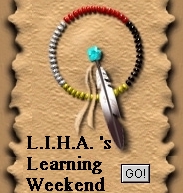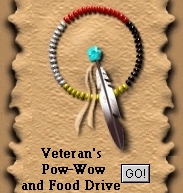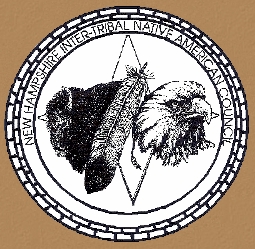Here is the PDF order form for the
Native American Veterans Monument Pavers
Posted Here!
-
This is in PDF format and you will need Adobe Acrobat Reader to allow you to read and print this page.


A little about who we are.

The New Hampshire Intertribal Native American Council is an alcohol and drug free Organization.
(Illegal Drug use and alcohol consumption will not be tolerated during meetings, ceremonies, or any social activities Powwows, festivities, teachings etc~ sanctioned and/or organized by the New Hampshire Intertribal Native American Council.)
The New Hampshire Intertribal Native American Council does not represent any one particular Native American Nation. We are made up of many Nations, Tribes, Clans, and People whom reside in and around, the State of New Hampshire.
Mission:
1. To create a culturally integrated organization to identify, unity, support, and service the cultural and non-cultural needs of the various Native American Indian people. their descendants and organizations residing within the State of New Hampshire.
Purpose;
1. To provide services and resources to assist all Native American Peoples that have been assimilated into the general population of New Hampshire, so that they may live without hunger, to be clothed, to have proper housing, and to expreience the spiritual and cultural awareness that is part of the Native American Heritage.
2. To provide a network of self help assistance and guidance for food, clothing, housing, and employment for all Native American People in times of need through the use of food pantries, clothing outlets, support groups, information centers, employment opportunities, and other resources.
3. To create a museum and library to preserve the spiritual and cultural heritage of Native American Peoples. Develop educational and cultural programs to teach the history, legends, lore, religion, language, and culture of Native American Peoples.
4. To support other Native American Tribal Councils, and Inter-tribal groups, and organizations in their efforts to preserve and promote Native American culture and concerns.
5. To provide opportunity for the sale of Council Members crafts, art, and other traditional handiwork to support the lives and interests of Native American People.
6. To work with local, State, and National organizations to provide enterprise to establish employment training and employment opportunities for Native American people. Promote Native American owned and operated business, services, manufacturing, or other industry.
7. To preserve and protect the People, animals, insects, plants, land, waters, and air of the ancestral lands of all Native American Peoples.
8. To collect and receive funds by way of gifts, contributions, grants, subscriptions, or other legal means consistent with the law and purposes of this organization as well as engage in other charitable purposes lawful in this State of New Hampshire.
9. To reach out and provide services as a clearing house for the dissemination of information and to promote a positive image relating to all Native American Peoples.




Other Educational Information.

The Majestic wolf.. Wolves are the most misunderstood of the wild animals. Although, there are many stories (some of them wild wives tales) there have never been any confirmed attacks and killings of humans by healthy wolves. Wolves are the epitome of the wild spirit. The wolf is a true spirit of the free and unspoiled wilderness.
There are several types or species of wolves.. The Red Wolf is the smallest (and it may also be extinct in the wild), The Mexican Wolf, The Arctic Wolf, and the gray Timber Wolf..The gray Wolf is not always gray, it may be black, gray, brown, white, or various combinations...



The feathers that Native Americans (Indians) wear in their hair were very important to them. Most feathers were more than just decoration. The feathers siginified some great honor such as being the chief of a tribe, or a hero in battle. And some denote rank in a tribal or clan's society.



There are 59 species of eagles, and they are often divided into one of four categories. (1.) Fish and Sea Eagles ( those who live primarily upon a diet from the sea or rivers) (2.) Snake Eagles (often have crests upon their heads) (3.) Harpy or Giant Forested Eagles (are not found on this continent but are the largest member of the Eagle family) and (4.) Booted Eagles..(the Golden Eagle is a member of this family)
There is a great variety within thes four groups. When it comes to coloring, and feather patterns, every eagle is unique and beautiful in it's own way. The bald Eagle is a part of the first category of Eagles. (Water and Fish)
The feathers of Eagles are sacred to Native Americans. The Bald Eagle and the Golden Eagle are the most important to those upon this continent. The Bald Eagle is Larger that the Golden Eagle. The Bald Eagle is a symbol of the feminine while the gold is a symbol of the masculine. Both of these Eagles have come to symbolize heroic nobility and Divine spirit.



The American Buffalo is actually a Bison. Buffalo is a name that applies to the animals of Asia and Africa. To the Plains Indians the Bison is a symbol of sacred life and abundance. The Bison is a large animal and they can weigh up to a ton and a half. It has a massive head, humped shoulders, and some say an almost exaggerated appearance because of it's shaggy fur. The Bison is very unpredictable. And it is a very dangerous animal.. When the Native Americans killed the Bison they used every part of the animal that they had killed... The meat was their food.. It was dried and stored. The skins were used for their clothing and tepees. The hair was used to line saddle bags, make pillows and put into sleeping pads.. The sinews became their bow strings. From the hooves the Native People made glue. And in the stomaches and bladders the Native people carried water. And from the bones jewlery and pipes were made.. And the heads of the Bison were painted and placed facing the east. The Bison use their massive heads to clear patches of snow in the winter time so that it can feed upon the grasses beneath the snow.. The Bison will on occasion use it's head or horns to push or bowl things out of it's way. The Bison make several different sounds but the most common is the snort..



The bear is a powerful symbol in the Native American culture. The bear is also an image in myth and lore. The bear is the largest of carinvores. But the bear can also be considered omnivorous, eating both plants, fruits, fish, and meats. The bear actually eats less meat than the smaller carnivores such as the fox. All bears are astonishingly swift. The Black bear, and the Grizzly bear can run up to speeds of 35 to 40 MPH or 60 to 65 KPH for short distances. All bears including the Polar bear can climb.. Only the size of the tree will discourage climbing. Bears in the wintertime live off their excess stored up body fat, their body temperature drops about 12 to 14 degrees, their kidneys shut down completely, and their breathing rate can be cut down by as much as half.. The depth of sleep depends on the amount of stored body fat.. Although distantly related to the dog, the bear is closer related to the raccoon.. There is a variety of bears. The most common bear is the Black bear. This is kind of a misnomer, as not all Black bears are black. They can be brown, cinnamon, and various other combinations. The very largest of the bears is the the Alaskan Brown bear. It is a relative of the Grizzly bear, the Brown bear is relatively solitary. The Grizzly is well known for it's strength and ferocity.. Even though the Grizzly can be quite fierce, it is not naturally aggressive. By far the Most outstanding hunter is the Polar bear. This white bear has NO fear.. it is the most carnivorous and the most aggressive of all the bear species. It feeds greatly on seals and fish.



The Wolf is currently being re-introduced into some areas in the United States... Probably the biggest misconception of wolves is about their size..They are not nearly as large as most people imagine.. Their thick fur gives the appearance of a greater size, but they are usually no taller than a good sized German-Shepherd. Every member of the wolf pack knows its place in the hierarchial structure of that wolf pack.. There is the ALPHA male and the ALPHA female. The ALPHA male and ALPHA female often mate for life.. Wolves become sexually mature by the age of 22 to 24 months. The ritualistic behaviors that establish the wolf ranks are part of it's magic.. Wolf packs are not entirely autocratic - under the supreme rule of the ALPHA member... Neither are they democratic.. There are times when both occur, and it is the flexibility which adds to the success of the wolf government.



Wampum, ke`kwuk, squau-tho-won;
Wampum, ke`kwuk, squau-tho-won; all are Algonquian words for shell beads or string of shell beads. Wampumpeage is a Narragansett word for "white beads strung". Throughout northeastern America, wampum was used for jewelry, gifts, communication, historical record of important events, religious ceremonies, and trade. It was the earliest form of currency known in North America. Its value was derived from the difficulty involved in producing the cylindrical bead from both Quahog and Whelk, and the scarcity of suitable shells. White beads were made from Whelk, purple-blackish from Quahog.
The beads were produced from the inner spiral of the shells. The spiral or columna must be thick enough to withstand grinding, shaping and drilling. The shells were collected along the coastal shores during the summer, and worked in the winter months. The inner spirals were cut into cylinders measuring 1/4 inch long by 1/8 inch diameter. Each bead was then smoothed through grinding, polished, drilled, and finally strung on hemp fibers or sinew. It was difficult, tedious, and time consuming work. The proportionate scarcity of the Quahog dark beads doubled their value to that of white wampum.
Though wampum is most often associated with the Iroquois, and there are claims that the Iroquois were the first producers of wampum beads, it is more likely that the Iroquois were introduced to wampum by trade. The Iroquois lived in the interior, whereas sea shells could be found only in the coastal regions. The Narragansetts were most probably the first producers of wampum, with other coastal Algonquians, including the Delaware, following shortly thereafter.
Wampum was a firmly established base of currency by the time of increased European colonial settlements in the 17th century. Though it did have a monetary value, its sole purpose for the colonials, it was by no means limited to an economic role. As stated above, wampum was used for a multitude of purposes, not least of which was the binding truth to words "written" in wampum. So respected and important was it that an accompanying belt of wampum gave great solemnity to messages, speeches, and agreements. A message delivered via a wampum belt is said to have been greater than a thousand words, and it was accepted as truth. It was the seal, the proof of covenants made. The oldest extant wampum belt is the Huron belt given to the Jesuits to commemorate the first mission house built in Huronia. Offered and accepted in 1638, the Huron belt is currently housed in the Vatican.
With the influx of more Europeans in the 17th century, notably the Dutch and English, metal tools became widely available to Indians in the east. Among these tools were slender metal drills which greatly facilitated the production of wampum. These new tools enabled the Indians to produce uniform beads more quickly and with greater ease. Applying basic economic principles to wampum as a commodity/currency in the 17th century, it might be assumed that wampum decreased in value as its production was sped up. On the contrary, its value remained stable. Again applying the basic economic rule of supply and demand, though the Europeans brought tools that helped to increase wampum production, they also balanced their contribution with an increased demand for the shell beads.
Wampum remained the standard legal tender of both Indians and New England colonists until nearly the end of the 17th century. It was, in the words of New England economic historian William Weeden, "the magnet which drew the beaver out of the interior forests." Though the New Englanders prized it solely for its economic value, the Algonquians and Iroquois continued to utilize wampum for ornamentation, communication, ceremonial use, and as a reminder of the solemnity of agreements.
For communication purposes, wampum remained the "bead" of choice. Runners carried wampum belts from one village to another bringing news. The recipients of these messages knew as the runner approached whether or not he brought tidings of great joy, or that he was the bearer of bad news. A belt primarily worked in white beads was a good sign. A belt with a predominance of purple was cause for fear and apprehension. It may mean war, disaster, or a death announcement.
Ornamentation uses of wampum included bracelets, anklets, necklaces, belts, straps, and headbands. Decorative items of wampum were signs of wealth. One who wore several adorning items of wampum was a well off, or respected person. Sachems would have need of much wampum, as they had need of many other valuable possessions. An expectation of a New England sachem was that he be a generous gift giver. A gift of any of these was much appreciated, deserving of a fine return (the term "Indian giver" arose from the Indian custom to expect a gift in return for a gift). A woman would often have wampum earrings, perhaps a sash, and anklets. Delaware women frequently wore belts and headbands of woven strands of wampum, while the Iroquois and Mohicans, men and women, favored several single strand wampum necklaces.
As the New England colonists adopted wampum as their standard currency, incidents of fraud (wampum counterfeit) increased. Both Indian and Englishman were known to pass off inferior or fraudulent wampum to unsuspecting colonials. In time, regulation and a standardized measure of wampum strands was implemented. A fathom (6 feet) was the most usual measurement and instantly denoted a specific monetary value measured against English shillings, pence, pounds, and so forth. The fact that legislation was introduced, regulations regarding wampum manufacture were set down, penalties for counterfeit or inferior quality wampum trading were harsh, and in some colonies the rejection of dark wampum for only white (though its value was greater, it was easier to counterfeit by way of dye), all illustrate how dependent the colonists and Indians were on these shell beads. There was some fluctuation in wampum's value, as is always the case with currency, but by and large, it remained uniformly acceptable and desirable to nearly the end of the 17th century in the colonies and into the 18th century along the frontiers. Its worth, however, was tenable. Wampum was only good as long as the Indians prized it. If or when that was no longer the case, an economic crash could occur throughout the English colonies that would have had serious consequences in New England, and subsequently, in the mother country as well. It was this realization, along with the declining demand for fur, that moved the New Englanders to gradually phase out wampum as a currency standard. With silver from the West Indies beginning to circulate in North America, wampum was slowly being replaced by that universally valued commodity, metal coinage.
The Mohicans and Mohawk both operated as brokers in the wampum exchange throughout the 17th century. It was a lucrative venture to all involved, a point that is highlighted by Mohawk frustration at their inability to access the wampum producing coastal tribes during the Mohican/Dutch alliance. It was important enough to be the object of diplomacy and compromise during the treaty discussions in which the Dutch mediated. (The Dutch even tried their hand at producing wampum beads, but the Indians would not accept it, thereby making it useless.) The resulting agreement upheld the Mohicans possession of their Hudson Valley lands and rights to the fur trade, while the Mohawk were to be permitted to cross these lands to access the wampum makers. Both tribes traded wampum to others in the west and north, and were major suppliers to the Seneca.
By the mid 18th century, during the French and Indian War, the use of wampum as currency had declined so much that the Indians themselves were rejecting it as payment. They too wanted silver in exchange for their furs and services, and would often turn to the Dutch settlements, rather than the English, for their trading ventures.
Wampum remained long in use for ornamentation purposes, though even in this area it began to decline. More and more trade items were being adapted to suit the styles and traditions of Indian people in the east. Wampum belts, however, as proof of good will and binding agreements, continued. Some Indian people still possess the belts their ancestors wove to record and commemorate events and covenants of earlier days. With great respect, these belts are kept by the people. Wampum belts that serve as solemn reminders of past agreements are still extant. The most famous of these is the Iroquois Covenant belt, given in 1794 to the Iroquois Confederacy by the United States government to mark the great covenant between the two nations.
It is interesting, if not ironic, to note that wampum remains valuable even today. A single wampum bead made from Quahog or Whelk, manufactured in New England coastal areas can cost up to $10! Overseas wampum is less expensive, but still demands a good price. Wampum, the first currency of the new world, has survived as a desired item long enough to be considered a classic.
|

























